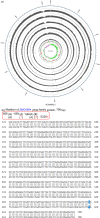Cold plasma pretreatment reinforces the lignocellulose-derived aldehyde inhibitors tolerance and bioethanol fermentability for Zymomonas mobilis
- PMID: 37322470
- PMCID: PMC10273749
- DOI: 10.1186/s13068-023-02354-8
Cold plasma pretreatment reinforces the lignocellulose-derived aldehyde inhibitors tolerance and bioethanol fermentability for Zymomonas mobilis
Abstract
Background: Lignocellulose-derived aldehyde inhibitors seriously blocked the biorefinery of biofuels and biochemicals. To date, the economic production of lignocellulose-based products heavily relied on high productivities of fermenting strains. However, it was expensive and time-consuming for the achievable rational modification to strengthen stress tolerance robustness of aldehyde inhibitors. Here, it aimed to improve aldehyde inhibitors tolerance and cellulosic bioethanol fermentability for the chassis Zymomonas mobilis ZM4 pretreated using energy-efficient and eco-friendly cold plasma.
Results: It was found that bioethanol fermentability was weaker in CSH (corn stover hydrolysates) than that in synthetic medium for Z. mobilis, and thus was attributed to the inhibition of the lignocellulose-derived aldehyde inhibitors in CSH. Convincingly, it further confirmed that the mixed aldehydes severely decreased bioethanol accumulation through additional aldehydes supplementary assays in synthetic medium. After assayed under different processing time (10-30 s), discharge power (80-160 W), and working pressure (120-180 Pa) using cold atmosphere plasma (CAP), it achieved the increased bioethanol fermentability for Z. mobilis after pretreated at the optimized parameters (20 s, 140 W and 165 Pa). It showed that cold plasma brought about three mutation sites including ZMO0694 (E220V), ZMO0843 (L471L) and ZMO0843 (P505H) via Genome resequencing-based SNPs (single nucleotide polymorphisms). A serial of differentially expressed genes (DEGs) were further identified as the potential contributors for stress tolerance via RNA-Seq sequencing, including ZMO0253 and ZMO_RS09265 (type I secretion outer membrane protein), ZMO1941 (Type IV secretory pathway protease TraF-like protein), ZMOr003 and ZMOr006 (16S ribosomal RNA), ZMO0375 and ZMO0374 (levansucrase) and ZMO1705 (thioredoxins). It enriched cellular process, followed by metabolic process and single-organism process for biological process. For KEGG analysis, the mutant was also referred to starch and sucrose metabolism, galactose metabolism and two-component system. Finally, but interestingly, it simultaneously achieved the enhanced stress tolerance capacity of aldehyde inhibitors and bioethanol fermentability in CSH for the mutant Z. mobilis.
Conclusions: Of several candidate genetic changes, the mutant Z. mobilis treated with cold plasma was conferred upon the facilitated aldehyde inhibitors tolerance and bioethanol production. This work would provide a strain biocatalyst for the efficient production of lignocellulosic biofuels and biochemicals.
Keywords: Bioethanol; Cold atmosphere plasma (CAP); Genome resequencing; RNA-Seq sequencing; Zymomonas mobilis.
© 2023. The Author(s).
Conflict of interest statement
The authors declare no competing interests.
Figures







Similar articles
-
Increasing cellulosic ethanol production by enhancing phenolic tolerance of Zymomonas mobilis in adaptive evolution.Bioresour Technol. 2021 Jun;329:124926. doi: 10.1016/j.biortech.2021.124926. Epub 2021 Mar 2. Bioresour Technol. 2021. PMID: 33684841
-
Development and characterization of acidic-pH-tolerant mutants of Zymomonas mobilis through adaptation and next-generation sequencing-based genome resequencing and RNA-Seq.Biotechnol Biofuels. 2020 Aug 13;13:144. doi: 10.1186/s13068-020-01781-1. eCollection 2020. Biotechnol Biofuels. 2020. PMID: 32817760 Free PMC article.
-
Transcriptome analysis of Zymomonas mobilis ZM4 reveals mechanisms of tolerance and detoxification of phenolic aldehyde inhibitors from lignocellulose pretreatment.Biotechnol Biofuels. 2015 Sep 22;8:153. doi: 10.1186/s13068-015-0333-9. eCollection 2015. Biotechnol Biofuels. 2015. PMID: 26396591 Free PMC article.
-
New technologies provide more metabolic engineering strategies for bioethanol production in Zymomonas mobilis.Appl Microbiol Biotechnol. 2019 Mar;103(5):2087-2099. doi: 10.1007/s00253-019-09620-6. Epub 2019 Jan 19. Appl Microbiol Biotechnol. 2019. PMID: 30661108 Review.
-
Comprehensive network of stress-induced responses in Zymomonas mobilis during bioethanol production: from physiological and molecular responses to the effects of system metabolic engineering.Microb Cell Fact. 2024 Jun 18;23(1):180. doi: 10.1186/s12934-024-02459-1. Microb Cell Fact. 2024. PMID: 38890644 Free PMC article. Review.
Cited by
-
Taurine-mediated gene transcription and cell membrane permeability reinforced co-production of bioethanol and Monascus azaphilone pigments for a newly isolated Monascus purpureus.Biotechnol Biofuels Bioprod. 2024 May 3;17(1):59. doi: 10.1186/s13068-024-02511-7. Biotechnol Biofuels Bioprod. 2024. PMID: 38702823 Free PMC article.
-
Itaconic acid production from corn stover hydrolysates for a newly isolated Aspergillus terreus through adaptive evolution.Bioprocess Biosyst Eng. 2025 Jul;48(7):1069-1087. doi: 10.1007/s00449-025-03161-1. Epub 2025 Apr 14. Bioprocess Biosyst Eng. 2025. PMID: 40227479
-
Cold Plasma Treatment Facilitated the Conversion of Lignin-Derived Aldehyde for Pseudomonas putida.Appl Biochem Biotechnol. 2025 Feb;197(2):1329-1343. doi: 10.1007/s12010-024-05082-3. Epub 2024 Nov 21. Appl Biochem Biotechnol. 2025. PMID: 39570516
References
-
- Wu M, Di J, Gong L, He YC, Ma C, Deng Y. Enhanced adipic acid production from sugarcane bagasse by a rapid room temperature pretreatment. Chem Eng J. 2023;452:139320. doi: 10.1016/j.cej.2022.139320. - DOI
Grants and funding
LinkOut - more resources
Full Text Sources
Molecular Biology Databases
Miscellaneous
